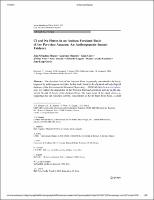Mostrar el registro sencillo del ítem
Cl and Na Fluxes in an Andean Foreland Basin of the Peruvian Amazon: An Anthropogenic Impact Evidence
| dc.contributor.author | Moquet, Jean-Sébastien | |
| dc.contributor.author | Maurice, Laurence | |
| dc.contributor.author | Crave, Alain | |
| dc.contributor.author | Viers, Jérôme | |
| dc.contributor.author | Arevalo, Nore | |
| dc.contributor.author | Lagane, C. | |
| dc.contributor.author | Lavado-Casimiro, W. | |
| dc.contributor.author | Guyot, J.L. | |
| dc.date.accessioned | 2021-07-01T19:08:27Z | |
| dc.date.available | 2021-07-01T19:08:27Z | |
| dc.date.issued | 2014-09-14 | |
| dc.identifier.citation | Moquet, JS., Maurice, L., Crave, A. et al. (2014). Cl and Na Fluxes in an Andean Foreland Basin of the Peruvian Amazon: An Anthropogenic Impact Evidence. Aquat Geochem 20, 613–637. https://doi.org/10.1007/s10498-014-9239-6 | es_PE |
| dc.identifier.uri | https://hdl.handle.net/20.500.12542/1028 | |
| dc.description.abstract | The dissolved load of the Amazon River is generally considered to be lowlyimpacted by anthropogenic activities. In this work, based on the chemical and hydrologicaldatabase of the Environmental Research Observatory—HYBAM (http://www.ore-hybam.org), we explore the importance of the Peruvian Foreland petroleum activity on the dis-solved Na and Cl fluxes of the Amazon River. The main result of this study allows ussuggesting that oil extraction activity, concentrated in the El Tigre River basin, a small foreland watershed in the Peruvian Amazon, influenced drastically the Na and Cl expor-tation of the Amazon River during the 2006–2007 period. During these years, the dis-solved exportations of this basin represented almost 20 % of the annual dissolved ClAmazon flux and almost 12 % of the annual dissolved Na Amazon flux for a mean annualdischarge\1 % of the Amazon River discharge. Since the last decades, the anthropogenicactivities are increasing over the whole Amazon basin, especially in Andean countries. Inthis context, our results demonstrate that extractive activity cannot be considered asnegligible on the hydro-chemistry of the Amazonian Rivers especially for the weatheringbudget estimation based on river-dissolved loads. Moreover, Cl and Na can be used to tracethe formation waters derived from oil extraction at a large spatial scale. The environmentalimpacts of contaminants associated with deep water released to the hydrosystem (poly-cyclic aromatics hydrocarbons, metallic trace elements, etc.) at local and regional scalesare still underestimated and should be monitored to map their local and regional influenceand to prevent their risks on human health. | es_PE |
| dc.format | application/pdf | es_PE |
| dc.language.iso | eng | es_PE |
| dc.publisher | Springer | es_PE |
| dc.relation.uri | https://link.springer.com/article/10.1007/s10498-014-9239-6 | es_PE |
| dc.rights | info:eu-repo/semantics/openAccess | es_PE |
| dc.rights | Reconocimiento - No comercial - Sin obra derivada (CC BY-NC-ND) | es_PE |
| dc.rights.uri | https://creativecommons.org/licenses/by-nc-nd/4.0/ | es_PE |
| dc.source | Repositorio Institucional - SENAMHI | es_PE |
| dc.source | Servicio Nacional de Meteorología e Hidrología del Perú | es_PE |
| dc.subject | Petróleo Mineral | es_PE |
| dc.subject | Extracción de Petróleo | es_PE |
| dc.subject | Contaminación de Petróleo | es_PE |
| dc.subject | Aguas Minerales | es_PE |
| dc.subject | Hidrocarburos Aromáticos | es_PE |
| dc.subject | Cuencas | es_PE |
| dc.subject | Andes | es_PE |
| dc.subject | Amazonia | es_PE |
| dc.subject | Factor Antropogénico | es_PE |
| dc.title | Cl and Na Fluxes in an Andean Foreland Basin of the Peruvian Amazon: An Anthropogenic Impact Evidence | es_PE |
| dc.type | info:eu-repo/semantics/article | es_PE |
| dc.identifier.doi | https://doi.org/10.1007/s10498-014-9239-6 | |
| dc.subject.ocde | https://purl.org/pe-repo/ocde/ford#1.05.11 | es_PE |
| dc.subject.sinia | actividad petrolera - Economía Ambiental y Bionegocios | es_PE |
| dc.type.sinia | text/publicacion cientifica | es_PE |
| dc.identifier.url | https://hdl.handle.net/20.500.12542/1028 | |
| dc.identifier.url | https://hdl.handle.net/20.500.12542/1028 |
Ficheros en el ítem
Este ítem aparece en la(s) siguiente(s) colección(es)
-
Artículo científico [177]









